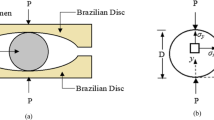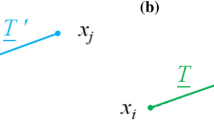Abstract
Concrete is a brittle composite material where the failure mechanism is closely related to the initiation and propagation of cracks. The presence of microcracks and other defects in concrete allows, unlike in the case of an ideal brittle material, the existence of a failure process that includes the branching and bifurcation of the cracks, which gives rise to the appearance of an inelastic behavior and then to a higher energy consumption during failure and an extension of the zone in which fracture takes place. This work studies the failure behavior of damaged concretes in tension and compares the behavior of concrete of different strength levels and component materials when adopting temperature as the damaging tool. Two water/cement ratios, two types of coarse aggregates and the incorporation of natural pozzolans are included as variables. As a way to evaluate the damage produced in the internal structure of concrete, the dynamic modulus of elasticity was measured on each specimen. Measures of strength, deformability, and fracture energy determined over notched prisms are reported. In a complementary way, the results of compression tests (strength, static modulus of elasticity, and Poisson ratio) over cylindrical specimens are included.
Résumé
Le béton est un matériau composite fragile dans lequel le mécanisme de rupture est étroitement lié à un processus de formation et de propagation des fissures. La présence de microfissures et autres défauts dans le béton conduit, contrairement à ce qui se passe pour un matériau fragile idéal, à l'existence d'un processus de rupture qui comprend ramification et bifurcation des fissures, ce qui donne lieu à l'apparition d'un comportement inélastique; ceci entraîne une plus grande consommation d'énergie pendant la rupture ainsi qu'une extension de la zone dans laquelle s'est produite la fracture. Dans ce travail, on étudie le mécanisme de rupture de bétons endommagés sous des sollicitations de traction. On a adopté la température comme instrument d'endommagement en comparant le comportement de bétons ayant des résistances ainsi que des matériaux constitutifs différents. Les variables sont deux rapports eau/ciment différents, deux types de gros granulats et l'incorporation d'une pouzzolane naturelle. Afin d'évaluer les dommages produits dans la structure inteme du béton, le module d'élasticité dynamique a été mesuré dans chaque éprouvette. La résistance, la déformabilité et l'énergie de fracture se mesurent à l'aide d'éprouvettes prismatiques entaillées. À titre complémentaire sont rapportés les résultats de tests de compression obtenus avec des cylindres (résistance, module d'élasticité statique et coefficient de Poisson).
Similar content being viewed by others
References
‘Interfaces in cementitious composites’, Proceedings of the RILEM Int. Conf E. & FN SPON (J. C. Maso, LMDC, INSAUPS, Toulouse, France, 1992).
Mehta, P. K. and Monteiro, P. J. M., ‘Concrete: Structure, Properties and Materials’, (Prentice Hall, NJ, 1993).
Ziegeldorf, S., ‘Phenomenological aspects of the fracture of concrete’, in ‘Fracture Mechanics of Concrete’, F. H. Wittmann, Elsevier, NY 1983) 31–41.
Giaccio, G., Rocco, C. and Zerbino, R., ‘The fracture energy (GF) of high strength concretes’,Mater. Struct. 26 (161) (1993) 381–386.
Bažant, Z. and Kaplan, M., ‘Concrete at high temperatures’, (Longman, First edition, Essex, UK, 1996).
Abrams, M. S., ‘Compressive strength of concrete at temperatures to 1600°F’, in Temperature and Concrete’, ACI SP-25 (American Concrete Institute, Detroit, 1971) 33–58.
Zoldners, N. G., Malhotra, V. M. and Wilson, H. C. ‘Effect of high temperature on concretes incorporating different aggregates’,ASTMJ.60, (1960) 1087–1108.
‘Concrete for Nuclear Reactors’, ACI SP-34 (American Concrete Institute, Detroit, 1972).
RILEM TC-129 MHT, ‘Test methods for mechanical properties of concrete at high temperatures: Compressive strength for service and accident conditions’,Mater. Struct. 28 (181) (1995), 410–414.
RILEM TC-129 MHT, ‘Test methods for mechanical properties of concrete at high temperatures: Tensile strength for service and accident conditions’,Mater. Struct. 33 (228) (2000) 219–223.
Baker, G. ‘The effect of exposure to elevated temperatures on the fracture energy of plain concrete’,Mater. Struct. 29 (190) (1996) 383–388.
Papayianni, M. and Valiasis, T., ‘Residual mechanical properties of heated concrete incorporating different pozzolanic materials’,Mater. Struct. 24 (140) (1991) 115–121.
Zhang, B., Bicanic, N., Pearce, C. J. and Balabanic, G., ‘Residual fracture properties of normal-and high-strength concrete subjected to elevated temperatures’,Magazine of Concrete Research 52 (2) (2000) 123–136.
Mohamedbhai, G. T. G., ‘Effect of exposure time and rates of heating and cooling on residual strength of heated concrete’,Magazine of Concrete Research 38 (136) (1986) 151–158.
Felicetti, R. and Gambarova, P. G., ‘On the residual tensile properties of high performance siliceous concrete exposed to high temperature’, in the Proceedings of the International Workshop in honor of Z. P. Bažant's Anniversary (Prague, 1998), 1–20.
Barragán, B., Di Maio, A., Giaccio, G., Traversa, L. and Zerbino, R., ‘Effects of high temperature on residual mechanical and transport properties of concrete’, Proceedings of the Fifth CANMET/ACI International Conference on Durability of Concrete, ACI SP-192 (American Concrete Institute Barcelona, 2000) 983–1000.
Di Maio, A., Giaccio, G. and Zerbino, R., ‘Relationship between the static and dynamic modulus of elasticity of concretes exposed to high temperatures’. Proceedings of the V Iberoamerican Congress of Construction Pathogies and VII Congress of Quality Control (Montevideo, 1999) 331–338. (Only available in Spanish).
RILEM TC-50 FMC, ‘Determination of the fracture energy of mortar and concrete by means of three-point bend tests on notched beams’,Mater. Struct. 18 (106) (1985) 285–290.
Giaccio, G. and Zerbino, R., ‘Failure mechanism of concrete: Combined effects of coarse aggregates and strength level’,Advanced Cement Based Materials 7 (1) (1998) 41–48.
Author information
Authors and Affiliations
Additional information
Editorial Note The UPC is a RILEM Titular Member.
Rights and permissions
About this article
Cite this article
Barragán, B.E., Giaccio, G.M. & Zerbino, R.L. Fracture and failure of thermally damaged concrete under tensile loading. Mat. Struct. 34, 312–319 (2001). https://doi.org/10.1007/BF02482211
Received:
Accepted:
Issue Date:
DOI: https://doi.org/10.1007/BF02482211




